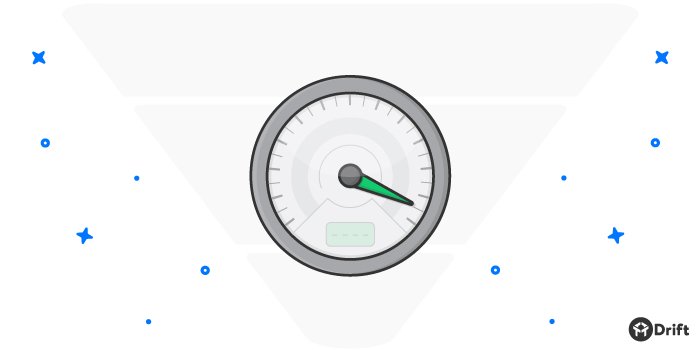
As a salesperson, the goal of inbound sales is to become a trusted resource — someone who can help your potential customers solve real problems.
And that requires researching and understanding the needs of those potential customers, as well as anticipating when they’ll be ready to buy.
Instead of striving for a quick close, inbound sales puts the emphasis on guiding leads through a “buyer’s journey.”
Typically, that journey consists of an awareness stage (when buyers realize they have a problem), a consideration stage (when buyers define that problem and start looking for solutions), and a decision stage (when buyers finally land on the solution they want).
I think most buyers would agree that this approach marks a significant improvement from the old school, brute-force approach to sales, which relied more heavily on persuasion, charm, and, in some cases, psychological trickery.
“You’re from Boston? No way, my mother’s from Boston! We have so much in common. Now, have I got the car for you…”
However, while inbound sales has certainly helped sales teams deliver a better buying experience over the past few years, it’s starting to show its age.
Room for Improvement
Just as search engines and social media transformed the way people bought (giving rise to inbound sales), messaging apps and live chat are now transforming the way people buy today.
Billions of people around the world are now using messaging by default, while phone and email are waning in popularity. In fact, 3 out of 10 consumers would give up phone calls altogether if they could use messaging instead.
Sales teams that fail to adapt to this shift in how people prefer to communicate will inevitably find their conversion rates taking a nosedive. (And already, they’re not very good.)
The average B2B lead-to-opportunity conversion rate is 13%, and it takes an average of 84 days for those leads to convert.
Meanwhile, the average B2B opportunity-to-deal conversion rate is 6%, and it takes an average of 18 days for those opportunities to close. (Source: Salesforce)
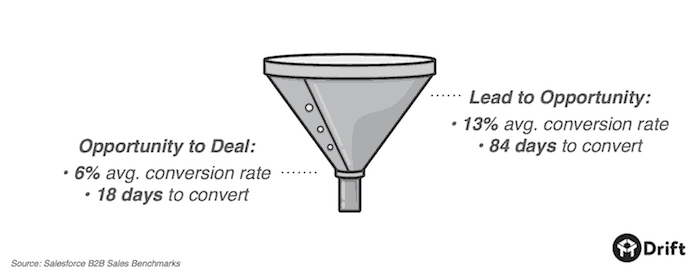
Compare those stats with some stats from my coworker Tanner on the sales team.
In his first week working at Drift, Tanner booked 12 meetings, had 8 of those meetings turn into opportunities, and of those 8 opportunities, had 3 turn into deals.
That puts Tanner’s lead-to-opportunity conversion rate at 67%, 5x the industry average, while his opportunity-to-deal conversion rate is 38%, 6x the industry average.
How did Tanner do it?
To find out, check out our 3 tips for making your inbound sales funnel more efficient…
1) Replace your lead forms (or at least add a second net to your website).
As I mentioned earlier, a major component of inbound sales is educating leads, and making sure they have the resources they need to make an informed decision.
“Helping is the new selling,” as we like to say at Drift.
But if that’s the case, how come 86% of the 433 sales teams we looked at in our lead management survey are still locking up their content behind forms?
Instead of engaging with leads and answering their questions while they’re at their most interested (while they’re live on your website), we’ve been telling them to leave their contact info and then get lost.
In a brick and mortar setting, that’d be like driving potential customers into an empty store — no salespeople greeting you as you walk in, no products on the shelves. There’d just be a clipboard on a dusty table, with the instructions: “Write down your contact info and we’ll follow up when we feel like it.”
Unfortunately, that’s what the inbound sales experience has turned into today. But thanks to live chat, you can now replace those cold, static lead forms with conversations.
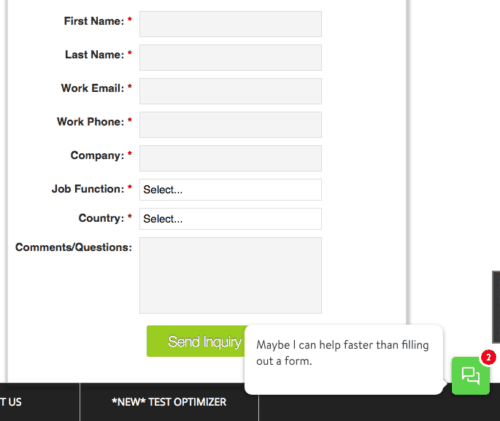
(Above: example of live chat in action on the Perfecto Mobile website)
With live chat, you’re not just capturing an email address when you generate a new lead, you’re learning about the needs of that particular lead, and you can answer their questions in real-time.
Of course, completely gutting your lead forms can be scary prospect. So if you’re not ready to take the plunge, we recommend adding live chat to your site as a “second net.”
That’s exactly what RewardStream did. And after 45 days of using live chat, they were booking 30% of their meetings through that “second net.”
Let’s face it: Your inbound sales funnel is probably leaking.
Live chat is how you catch the potential customers who are falling through the cracks.
2) Use bots to automate tedious tasks.
There’s a school of thought that says the rise of artificial intelligence and bots will make sales and marketing less personal.
But at Drift, we see it differently:
By automating the tedious tasks that typically bog salespeople down, bots are able to free up those sales reps so they can focus on having high-quality, human-to-human conversations.
In other words, by letting bots do what bots are good at (e.g. processing tons of information), sales reps can focus on what they’re good at (e.g. building relationships).
Here are some specific examples of how we use bots to make our sales process more efficient.
- Intelligent routing – Whenever a new live chat conversation comes in, we have a bot route that conversation to the right department and/or sales rep based on the person’s location and what they type into chat.

- Intelligent responses – Here’s something you’ll discover after having live chat up and running on your site for a while: People tend to ask the same, basic questions about your product over and over. So instead of always having to have a sales rep respond to those basic questions (that you already know the answers to), why not integrate a bot with your knowledge base and let the bot tackle those?
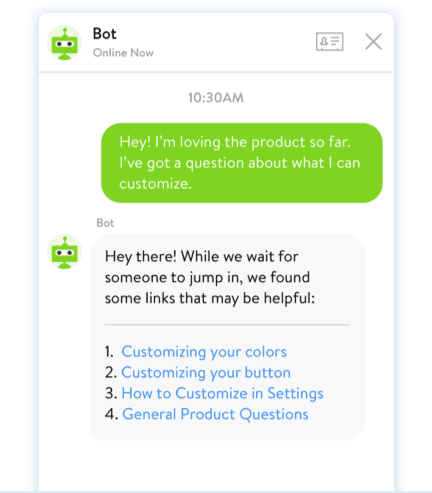
- Intelligent campaigns – Live chat doesn’t have to be passive. With LeadBot, you can send out targeted messaging campaigns designed to capture and qualify leads. Best of all, you can have these campaigns running 24/7, even when all your sales reps are asleep. (At Drift, our sales reps often wake up to discover meetings already booked on their calendars — thanks LeadBot!)
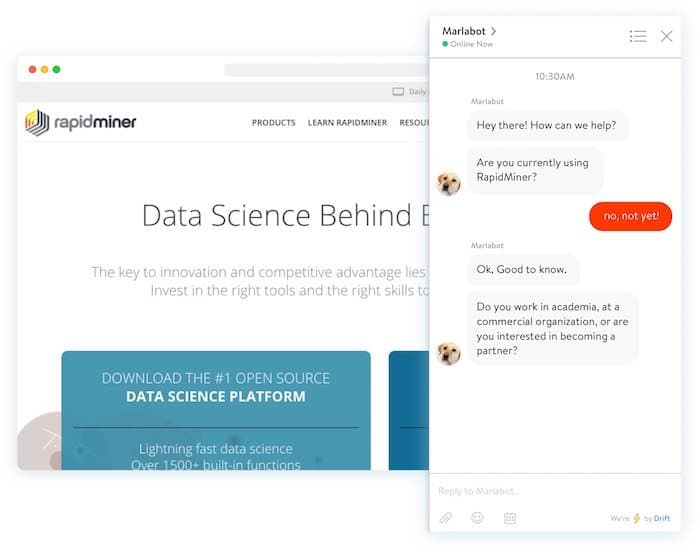
(Above: example of LeadBot in action on the RapidMiner website)
- Intelligent scheduling – Never-ending email chains and games of phone tag are huge drains on a sale rep’s productivity. With bots, potential customers can schedule meetings and demos with reps entirely through messaging, and the bots take care of surfacing available times and sending invites to both sides.
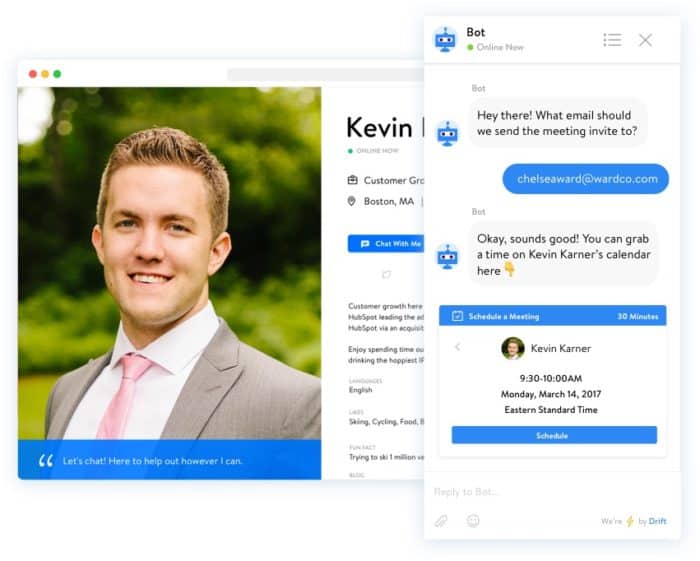
By using bots to automate the tedious tasks, you can let your salespeople focus on doing what they do best: answering complex questions, helping leads explore the different options and potential outcomes, and advising them on their purchase.
For more information on using bots for sales, check out this post: “Could Bots Make Your BDRs More Efficient?”
3) Don’t forget about your existing customers.
Inbound sales puts a strong emphasis on attracting new customers to your business. But what about those folks who have already bought?
At Drift, we use live chat to make sure our existing customers always have a direct line to our team so they can ask us questions and give feedback in real-time.
That way, we can continue to serve as a resource long after the deal is closed. And by having these ongoing conversations, we can identify opportunities for upselling.
Pro tip: Use bot campaigns to send targeted, in-app messages to your customers when you have news to share.
We tend to use these when we have new features to announce, and can have the message appear only in that area of our product where the new feature lives. We also target these messages to specific customers who we know would be a good fit for upgrading.
Final Thought: Embrace real-time selling.
Inbound was born in a time when email and phone (and to a lesser degree, social) were the dominant communication channels.
But now we know that real-time messaging is quickly becoming the next big channel.
To help your sales team adapt, we’ve developed a new methodology: Real-Time Selling™. Check out the SlideShare below for the full overview.
And, of course, if you have any questions, feel free to start a chat with us 🙂



